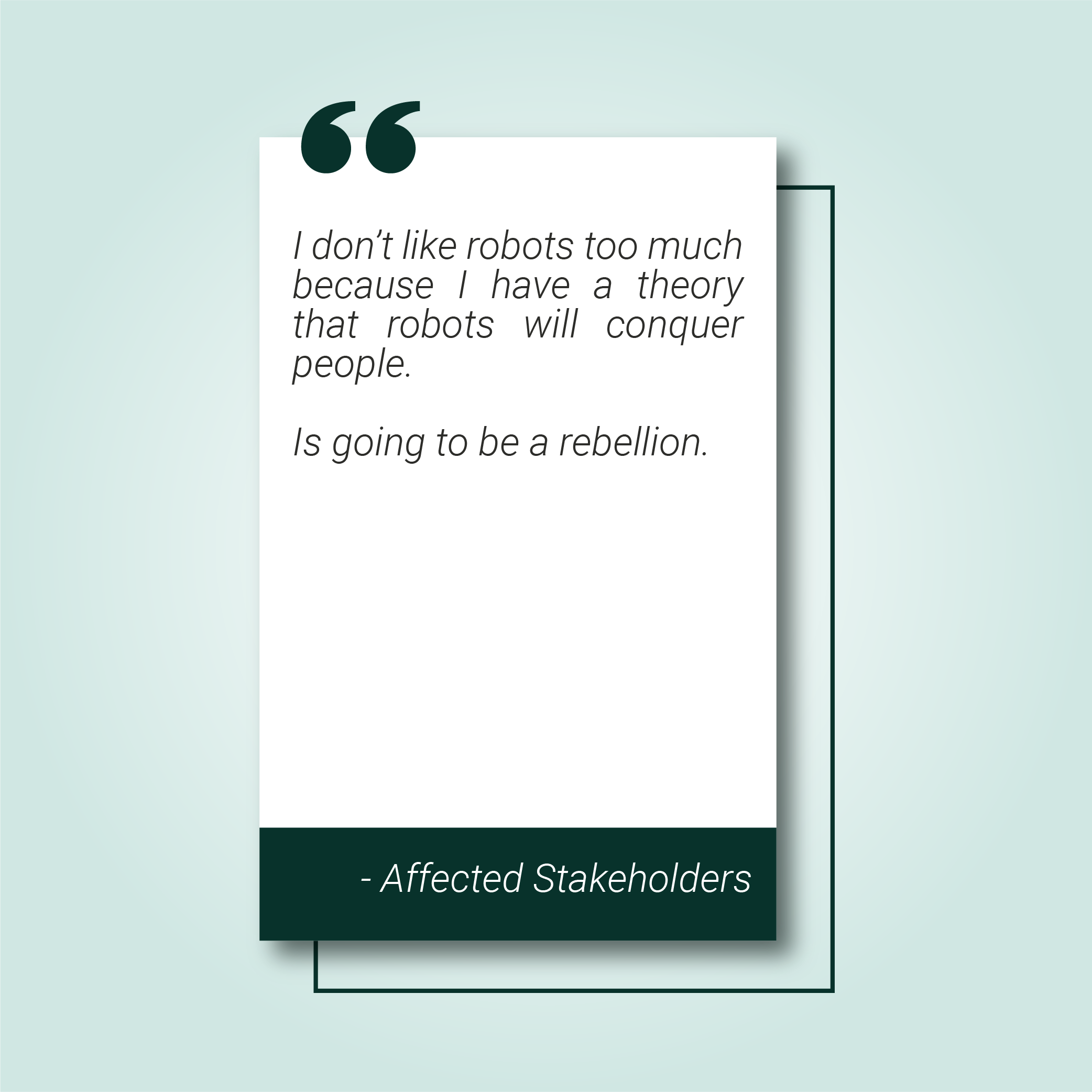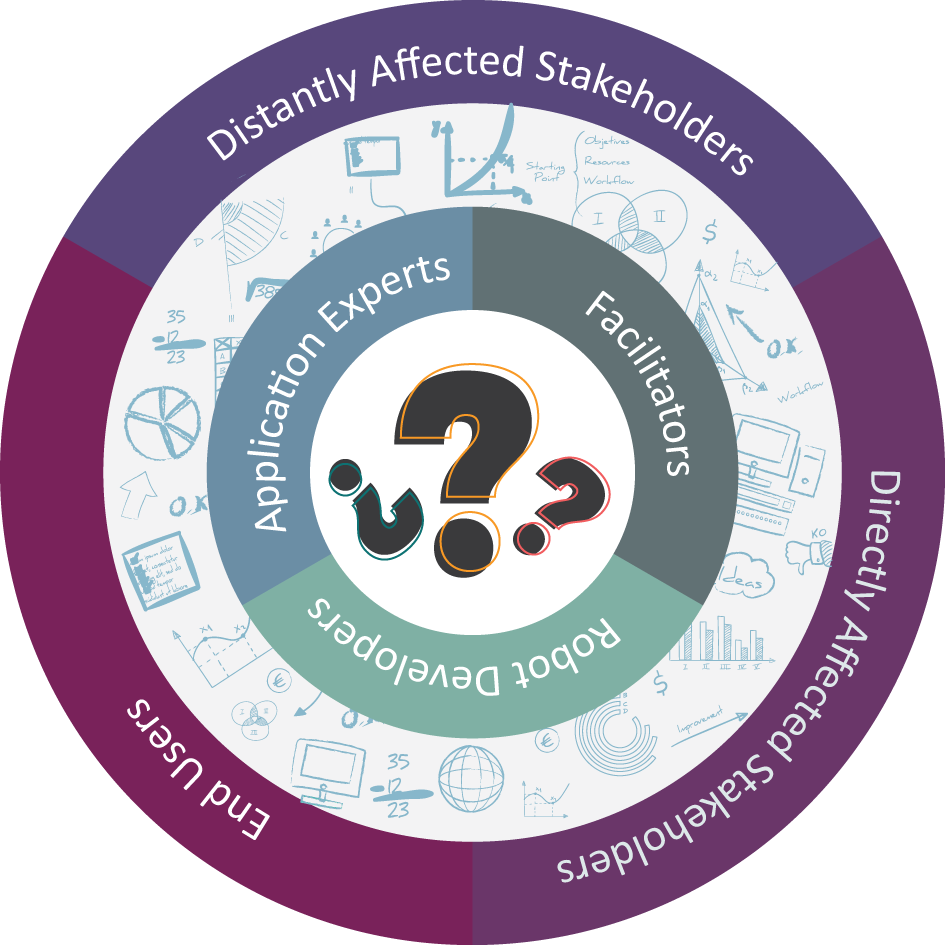Imaginaries around Robots
What are common perception of robots?
Scroll the bar to see the differences between reality and imaginaries.
The concept of robot exists in an intersection of public policy, cultural representation, technological innovation, capitalism and philosophy. Yet, no singular definition or understanding of what a robot is exists.
The same term is used to discuss entities potentially worthy of rights and responsibilities, automatic vacuum cleaners bumping into furniture, or classes of entities ranging from humanoid robot-partners to industrial robot arms.
Here we present the concept of imaginary to help make sense of the debate about the nature of robots, understood as both a concrete materiality and an abstract concept.


Human Proximity Model
Robot immaginaries are different to robot developers and affected stakeholders.
What is an Imaginary?
The concept of imaginaries comprises an interpretation of the present connected with a vision of the future. Depending on our vision of the future, we have, in the present, a way of interpreting the world. Adherents of a positive view of the future might interpret increasing automation as a good thing, since this brings humanity closer to the desired future, and vice versa.
These representations and imaginaries can shape our interactions with robots (Suchman 2007), our regulation of robots (Robertson 2014), and the creation of our common life-worlds (Hasse 2015).
What is a Robot?
Different definitions exist side by side. Some are concerned only with the mechanical configuration of materials, others add conceptual and functional properties also. Not surprisingly, Institute of Electrical and Electronics Engineers (IEEE) stated:
The term robot may have as many definitions as there are people writing about the subject. This inherent ambiguity in the term might be an issue when specifying an ontology for a broad community. We, however, acknowledge this ambiguity as an intrinsic feature of the domain.
Expand the tabs below to read the definitions of robots from the International Organization for Standarization (ISO) and IEEE.
A robot is an actuated mechanism programmable in two or more axes with a degree of autonomy, moving within its environment, to perform intended tasks. Autonomy in this context means the ability to perform intended tasks based on current state and sensing, without human interaction.
Robot: An agentive device in a broad sense, purposed to act in the physical world in order to accomplish one or more tasks. In some cases, the actions of a robot might be subordinated to actions of other agents, such as software agents (bots) or humans. A robot is composed of suitable mechanical and electronic parts.
These definitions center on a common theme, which we label materiality and processes. However, in our data, another perspective consistently turns up in the robot maker's characterization of what a robot is. This other perspective we call concept and function.
- Materiality and processes: refers narrowly to the technical aspect of robots, and deals with questions such as: Are robots necessarily physical, or can they be pure software? What sort of processes characterize a robot?
- Concept and function: deals with higher-order questions, which are, in principal, less tied to current technical development. Questions that fall within the theme of concept and function are: What is the purpose of robots in society? Are there certain roles, which robots should never fill? What will robots be like in the future?
Giving Voice
Click on to listen to the Affected Stakeholder. You can expand the content to full screen by clicking on the bottom right corner.
The Role of Media and Robot Makers
In the last few years, the presence of robots in the public media has increased immensely. Robots now often appear in movies, literature, on social media, and in the news. Yet, most people are still not exposed to robots in their everyday lives. Thus, most people rely on media, in the broad sense, for information about robots.
However, according to many robot makers, the information found in public media tends to paint a false picture of the current state of robotics.
- Humanoid: Entities that are human-like in appeareance.
- Imagination Horizon: A collectively available pool of conceptual resources, from which individuals draw out the elements constitutive of a given imaginary.
- Materiality and Processes: A theme relating narrowly to the technical aspect of a robot, i.e. which material properties (if any) must be present, and which processes must be instantiated for an entity to be a robot.
- Concept and Function: A theme grouping together phrases that pertain to the conceptual side of a robot.
- Anthropomorphism: The ascription of internal states characteristic of humans (such as emotions) to non-human entities (such as animals)
Key Concepts
Reflection Points
- When is it useful to show only some aspects of your robotic system and when is it necessary to explain all the aspects in detail? Could you give a concrete example?
- What is meant by intelligence in the context of robots? What is meant by autonomy?
- How might robot imaginaries affect your job as a robot developer when facing the end-user/customer expectations?
- What can you do to encourage a more realistic image of robots among the general public?
Concluding Remarks on Imaginaries
All affected stakeholders are exposed to imaginaries of robots. However, those who actually experience robots soon get a new perspective closer to the one shared by robot developers: that robots are machines. Many issues tied to affected stakeholders can be seen as a clash between expectations. The distantly affected stakeholders, who have never seen a robot, simply envision robots to be as agile and intelligent as humans. Consequently, it comes as surprise when a robot is, for instance, much slower than a human.
In light of this, we argue for a reality check. We wish to direct attention to discussions about robots that are real and currently bringing positive changes but also problems in workspace all over the world.
If you found this interesting, read more here:
Click here to Download Chapter 8: Imaginaries
Download
If you enjoyed reading about Imaginaries, you may also like:
By going over each icon with the mouse you will get a brief description of the corresponding topic.